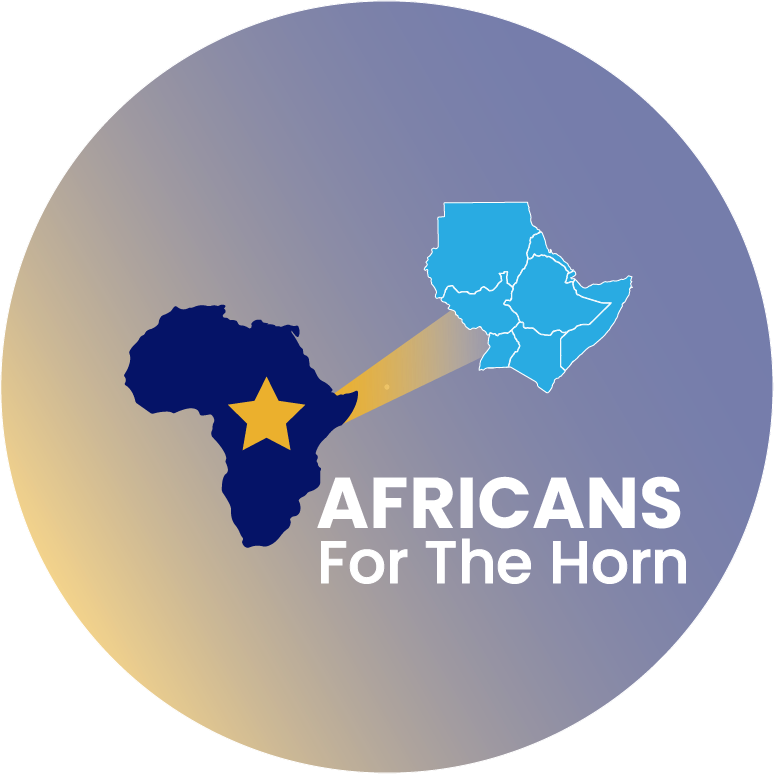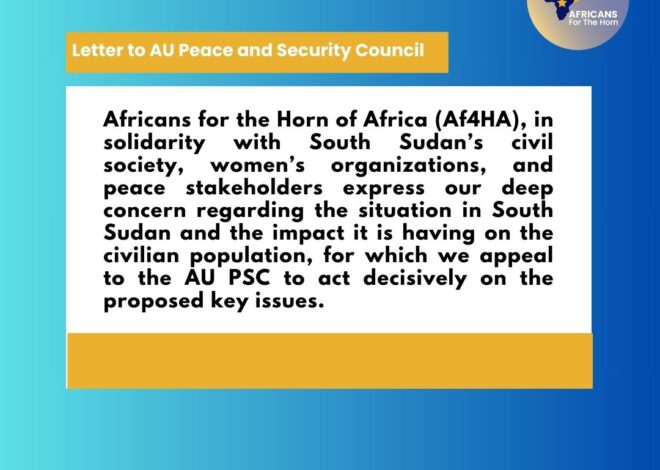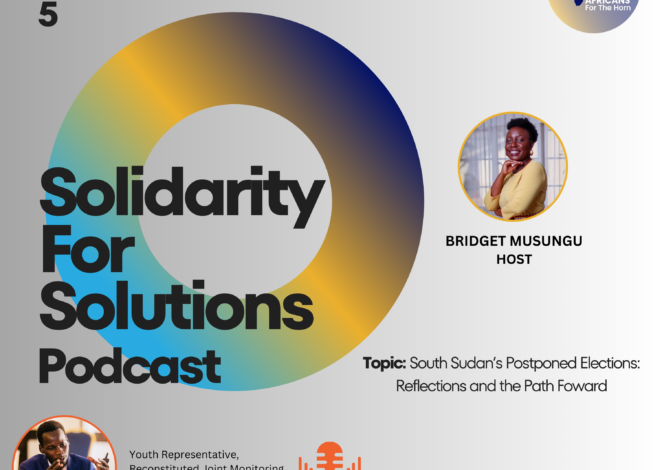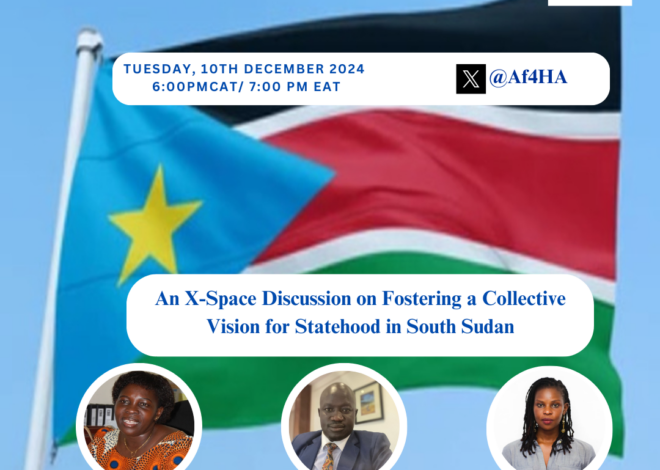South Sudan still trying to pick up the pieces

The country continues to grapple with the dilemma of either hastily navigating transitional processes, potentially repeating past disregard for popular will and exacerbating conflict, or extending the transitional arrangement, thereby bolstering the authority of leaders who have consistently failed to secure lasting peace, writes Maggie LoWilla
Africa Briefing
In 2011, South Sudan became the world’s youngest nation, following decades of civil war with Sudan. This dawn of independence sparked optimistic aspiration for the flourishing of democracy and lasting peace in the newly formed country. However, since then, the country has witnessed relapse into previous states of conflict.
This was first marked by the country’s descent into civil war from 2013-2015 and 2016-2018. These conflicts were ultimately resolved through peace processes, resulting in the Agreement on the Resolution of the Conflict in the Republic of South Sudan (ARCSS, 2015) and the subsequent Revitalised Agreement on the Resolution of the Conflict in the Republic of South Sudan (R-ARCSS, 2018).
The peace processes were underpinned by the liberal peacebuilding model, emphasising the importance of establishing democratic institutions, promoting human rights, and adopting market-oriented economic reforms to foster peace and stability in post-conflict societies. However, it is evident that the democracy-peace paradigm is nuanced, facing challenges and contradictions.
In the pre-colonial era, Southern Sudan largely existed outside state control. However, this quickly changed with the emergence of a centralised state under the Turco-Egyptian regime (1821-1885) and the rise of the slave trade and economic exploitation. This was followed by the Mahdist regime (1885-1898) which continued slave raids into southern territory.
In the pre-colonial
era, Southern Sudan
largely existed outside
state control
Throughout the colonial era (1899-1956), British policies exacerbated the division between northern and southern Sudan. This was evident in the preferential allocation of resources to northern Sudan and the imposition of restrictions on contact, interaction and trade between the two regions, deepening socio-economic disparities. Furthermore, under indirect rule, formerly fluid ethnic identities were shaped and cemented by colonial interpretations.
Upon gaining independence in 1956, Sudan lacked proper consultation and agreement among the integrated regions. The absence of a national consensus-building process through constitutional
means set a precedent of neglecting popular will.
The politics of exclusion during this period favoured a small segment of the population, marginalising the masses from governance. This catalysed the onset of violent elite-society interactions, notably
marked by the Anyanya I Rebellion (1955-1972) commonly known as the First Sudanese Civil War.
The insurgency concluded with the Addis Ababa Peace Agreement in 1972, which granted regional autonomy. However, this peace was short-lived, as conflict reignited in 1983 when President Nimeiri imposed Shari’a law to appease Islamist politicians. Led by the late Dr John Garang de Mabior, head of the Sudanese People’s Liberation Movement/Army (SPLM/A), the second insurgency was underpinned by his vision for a democratic New Sudan.
He advocated for a unified, secular state, seeking to dismantle political identities based on conquest, replacing them with a consensual national identity. The goal was to challenge the political supremacist connotations of Arabism and decentre Islam from governance, ensuring accurate representation of the diverse composition of Sudan’s population. Additionally, he envisioned the establishment of a Sudanese socio-political order based on equal standing regardless of religion, race, ethnicity, gender or place
of origin.
Despite the ideals and promise of New Sudan, it became less prominent, especially after Garang’s untimely passing in July 2005. Subsequently, South Sudan gained independence in January 2011, following a referendum that witnessed 98.83 per cent of South Sudanese vote for secession from North Sudan.
Following its independence, South Sudan struggled to build a national identity after the perceived defeat of its common enemy, Sudan. The absence of racial and religious distinctions from the politically dominant North led people to coalesce around sub-national ethnic identities.
This transition was anticipated, considering that a significant portion of the social and political landscape is centred on ethnicity. Despite this familiarity, the trust between different ethnic groups remained fragile, perpetuating “us” versus “them” dynamics.
Furthermore, with the establishment of a new state, ethnic rhetoric emerged to rationalise varying access to peace dividends, emphasising the roles of specific ethnic groups in the liberation struggle. This narrative gave rise to notions of ethnic supremacy, particularly among the Dinka and Nuer, reminiscent of the previously perpetuated racial superiority by the North. The ethnic disposition of the South Sudanese state further fuelled patrimonial politics dominated by the SPLM/A, expanding its influence when it assumed the supreme governing role of the state.
The SPLM/A’s exclusionary governance mirrored the authoritarian tendencies of the Khartoum regime, leading to debates about federalism. Historically marginalised communities, experiencing land dispossession and exclusion from the benefits of an independent South Sudan, were proponents of federalism.
However, some experts argued that decentralisation might exacerbate conflicts over smaller boundaries. The discourse on federalism is yet to be settled and is an ongoing point of contention.
It is important to note that most ethnic groups had their own forms of administration including chiefs, elders and young men (warriors) who served the role of protecting their community. While the warriors primarily served their own communities, they would sometimes serve at the behest of the state.
For example, armed Dinka cattle-raiders have alternately been integrated into the state, engaged in competition with the state, and been enlisted to safeguard state officials’ cattle. Similarly, the Nuer pastoralist group, often referred to as the “White Army”, was originally formed to defend the community cattle against raids. The group has evolved over time, participating in violence across phases of South Sudan’s conflicts.
These groups derive legitimacy and influence from cultural norms that highly value their capacity to protect their communities. Also noteworthy is the historical engagement of the Toposa warriors from Eastern Equatoria, who fought for and against the SPLA during the Second Sudanese Civil War, contingent on the SPLA’s ability to provide food and weapons. The willingness of young warriors to participate in violent conflict in exchange for material rewards points to the commodification of violence in South Sudan. It also adds a layer of complexity to transitional processes of Demobilisation, Disarmament and Reintegration (DDR) and Security Sector Reform (SSR), where the army is more malleable and not an exclusively arm of the state.
The task of developing the capacity to handle internal security amid ongoing inter-communal conflicts, addressing the presence of armed groups, and effectively managing the country’s resources to provide basic services was primarily delegated to the international community. This resulted in the absence of key elements essential for a functioning nation-state.
Despite the attempt to integrate numerous pre-independence militia into the SPLA, their organisational structures and command remained largely unchanged. SPLA units continued to be divided along ethnic and factional lines, with their former militia leaders assuming commanding roles as generals. In fact, the escalation of the 2016 conflict can be partly attributed to the blurred lines between state and communal
violence.
The Comprehensive Peace Agreement (CPA) signed in 2005 between the SPLM and the government of Sudan was a pivotal moment for South Sudan, leading to its independence independence in 2011. However, the CPA faced criticism for not adequately addressing internal tensions within South Sudan, neglecting issues like governance, corruption and resource distribution. The rushed implementation, particularly in integrating the SPLA and the Sudan Armed Forces (SAF), posed challenges in building unified security forces.
British colonial
policies exacerbated
the division between
northern and southern
Sudan
The DDR programme, crucial for the reintegration of ex-combatants was a vital component of the CPA. Despite having clear objectives, such as preparing ex-combatants for civilian life and reducing weapons proliferation, the programme faced various challenges. Hasty crafting of the CPA and a lack of detailed planning for DDR implementation contributed to the programme’s shortcomings.
The process lacked full community involvement, assumptions were made without considering the complex environment, and funding issues arose. Ultimately, less than a quarter of the DDR target was reintegrated, leaving many ex-combatants unemployed and susceptible to joining rebel groups.
The CPA and its accompanying peacebuilding initiatives failed to formulate a strategy for guiding the leaders and the populations of South Sudan towards a shared national vision. The leaders of the newly independent country directed their focus and resources primarily on the conflict with the North and the pursuit of individual interests.
The CPA’s objectives were not fully realised due to several factors, including a lack of political will, tensions among stakeholders, limited and delayed funding, economic challenges, lack of inclusion, and false assumptions. Furthermore, the exclusion of key stakeholders from negotiations and implementation contributed to the Agreement’s limitations. Therefore, though the CPA aimed to prevent violent state disintegration, it failed to bring lasting peace.
The Agreement on the Resolution of the Conflict in South Sudan (ARCSS), facilitated by the Intergovernmental Authority on Development (IGAD) in 2015, aimed to bring an end to the internal
conflict in South Sudan that broke out in 2013. However, the implementation of the agreement faced significant challenges, leading to a resurgence of violence.
The power-sharing arrangement between President Salva Kiir and Vice President Dr Riek Machar faltered, and the peace process lacked inclusivity, marginalising key stakeholders like civil society and women. South Sudan’s weak institutional infrastructure and a new and fragile governance culture further complicated the state-building process.
The ARCSS faced scrutiny for being a flawed and controversial peace deal, exacerbating tensions and power struggles. The history of conflict between the primary conflicting parties led to selective implementation and violations of the agreement, contributing to renewed conflict.
The mediation process itself was marked by deficits in preparedness, consent, impartiality, inclusivity and strategy, reflecting an unusually challenging context. Regional actors, notably IGAD’s frontline states, had competing national interests that outweighed their potential contribution to
the peace process.
While the IGAD-led peace process may have slowed South Sudan’s civil war and initiated discussions on necessary transformations, the peace deal lacked political will, broad national ownership, and specific implementing authorities. The principal combatants often demonstrated hostility toward negotiated settlements, which should have been an indicator of its impending failure.
The Revitalised Agreement on the Resolution of the Conflict in South Sudan (R-ARCSS) was signed in 2018 to resolve the 2016-2018 conflict. It is a revised version of the ARCSS, which aimed to rectify the flaws of its predecessor.
Unfortunately, it encountered similar challenges during implementation. Moreover, the agreement is often perceived to have been the outcome of external pressure from the international community and regional mediators, leading to fragility in power-sharing mechanisms and ongoing delays in implementation.
The agreement aimed to establish a permanent ceasefire, ensuring full implementation, and transitioning to democracy in the post-transitional period. However, critics raised valid concerns that the allocation of state power to non-state actors could potentially lead to insurgent violence, as evidenced in the ARCSS process, where contenders vying for power resorted to violence in the hope of exploiting peace negotiations.
While the R-ARCSS has prevented another full-blown civil war and initiated transitional institutions, challenges persist as political will for socio-economic justice reforms is insufficient. There are trust deficits among parties to the agreement, institutional capacity gaps, ongoing intercommunal violence, military defections, flooding, and humanitarian crises.
In fact, the humanitarian situation continues to worsen due to the influx of returnees and refugees fleeing the conflict in Sudan, coupled with food insecurity, climate-related shocks and violence. This highlights a limitation in the liberal peacebuilding model, where an excessive focus on institution-building tends to overshadow the basic needs of ordinary citizens and fails to deliver on the promise of peace.
All three political settlements were largely elitist and, in their implementation, have faced challenges related to a lack of political will, the persistence of ethno-political divisions, competition for resources, absence of effective DDR, inadequate implementation mechanisms, limited local buy-in and insufficient international oversight. The rushed and externally driven nature of these agreements often ignored the complex historical and socio-political dynamics within South Sudan.
In August 2022, signatories to the R-ARCSS agreed to extend the transitional period by 24 months. This included actions to be taken towards the completion of the outstanding tasks in the R-ARCSS and corresponding timeframes.
The roadmap agreement, while it may be seemingly reasonable, could also be perceived to be an opportunity for political actors to prolong their claim to power and access to state resources. In fact, this was a concern expressed by members of civil society, encompassing women’s groups, youth groups, persons with disabilities, human rights organisations, survivor groups, and academia, from across South Sudan and the diaspora who gathered in Dar es Salaam, Tanzania from November 21-23, 2023 to discuss the direction of South Sudan’s transitional process. The outcome of their discussion was a resolution titled: Civil Society Resolution on the Transitional Process in South Sudan. It agreed the following:
- “First, we need the killings, abductions, disappearances, torture, and sexual and gender-based violence (SGBV) to stop.
- “Second, we must prevent the recurrence of war in South Sudan. We cannot forge a nation through the barrel of a gun.
- “Third, meaningful peace can only be achieved through inclusive, participatory, and people-centred processes. When given the space to deliberate on how we will coexist peacefully, the people of South Sudan have demonstrated time and again that they have the wisdom and capacity to solve their own problems. Conversely, when decisions are forced upon us by a small political and military elite, it has only generated more violence.”
The last paragraph echoes this article’s earlier critique on the elitist nature of previous political settlements. The narrow focus centred on power-sharing and institution building, rather than broader social, political and economic empowerment has contributed to the rise of a ruling elite prone to rent-seeking, driving a wedge between state and society.
South Sudan’s political and military elite have mastered the manipulation of Western dominated peace processes for their personal gain, at the expense of the people, resulting in what appears to be a never-ending pursuit of an elusive peace. South Sudan’s post-independence experience demonstrates the challenges of imposing liberal formulas of state-building on a traditional and deeply illiberal society. The assumption that the mere presence of democratic institutions guarantees peace overlooks underlying issues such as ethnic cleavages, identity politics, proliferation of armed groups and power struggles. With the unresolved historical tensions, elections can easily become a flashpoint for violence rather than a mechanism for peaceful transition.
While certain aspects of the model have contributed positively to the state’s recovery, its weaknesses and challenges highlight the need for a more nuanced and context-specific approach. As the state navigates its path towards stability, addressing historical injustices and fostering local ownership in peacebuilding, efforts are essential for fostering a resilient and lasting peace.
Furthermore, it is critical that the state dedicates efforts towards defining a unified vision, values and collective aspirations of the South Sudanese people. Without effective leadership and a clear vision for sustainable peace, it will be even more daunting for both internal and external actors to unite around a strategy to advance such an agenda.
As the countdown to elections approaches, South Sudan stands at a crucial juncture. It must grapple with the dilemma of either hastily navigating transitional processes, potentially repeating past disregard for popular will and exacerbating conflict, or extending the transitional arrangement, thereby bolstering the authority of leaders who have consistently failed to secure lasting peace.
The South Sudan dilemma presents an intricate challenge, serving as a pivotal case study that demands deeper contemplation and a re-evaluation of Western assumptions. It alludes to the fact that achieving sustainable peace in post-conflict societies requires approaches that authentically align with the unique nuances and experiences of the particular context.
Maggie LoWilla, originally from South Sudan, is a Programme Associate at the African Leadership Centre in Nairobi
Read the original article on Africa Briefing



